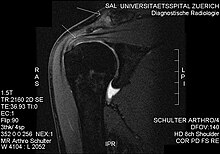Impingement
| Classification according to ICD-10 | |
|---|---|
| M75.4 | Impingement syndrome of the shoulder |
| M24.8 | Other specified joint damage, not elsewhere classified |
| ICD-10 online (WHO version 2019) | |
In orthopedics and trauma surgery, impingement syndrome (English "collision") is a functional impairment of joint mobility . It usually arises from degeneration or trapping of capsule or tendon material.
The term is mainly used for the shoulder. Degeneration or injury to the rotator cuff ( rotator cuff rupture ) is the most common cause here. Affected patients can hardly raise their arm above shoulder level due to the increasing entrapment of the supraspinatus tendon . The actual impingement occurs subacromially , i.e. below the shoulder joint , which is why the term subacromial syndrome (SAS for short) is used here.
The term is also used for other joints, especially the hip joint. The hip is usually a femoro-acetabular impingement caused by incomplete congruence of the femoral head (caput femoris) and the acetabulum . In the case of the hip, a distinction is made between pliers or pincer impingement and cam or cam impingement. The former starts from the socket and mainly affects women. The latter is based on a femoral head or femoral neck with a thickening and is more common in men.
causes
The term impingement describes a disease process in which anatomical structures “collide” in the joint.
Depending on the triggering Impingementursache is called synovial fluid - syndesmoses - band - and scars impingement or by a loose bodies or fixed joint body .
The most common reason for soft tissue impingement in the upper ankle is post- traumatic impingement, in which the joint capsule is trapped with scars, thereby reducing mobility.
Clinical picture
Typical in shoulder impingement syndrome is pain during abduction (spreading) of the upper arm in the range of 70 ° to 130 ° ( painful arc ), but the external and internal rotation in the shoulder are also more or less restricted. A positive Neer sign is required diagnostically here. The maximally pronated arm is passively raised with the shoulder blade fixed . Pain from 130 ° is considered positive and a sign of impingement. Furthermore, irritation of the supraspinatus tendon can also be achieved by maximum internal rotation with simultaneous abduction of the arm. This sign is called Jobe's Sign .
Further impingement syndromes are described for the elbow joint , the wrist joint , the hip joint , the knee joint and the upper ankle joint .
Differential diagnosis
Pain and restricted mobility of the shoulder also occur with calcification of the tendons (in the area of the rotator cuff, "calcified shoulder "), further alternatives can be found under frozen shoulder .
See also
literature
- Allen E. Fongemie, Daniel D. Buss, Sharon J. Rolnick: Management of Shoulder Impingement Syndrome and Rotator Cuff Tears . In: American Family Physician . tape 57 , no. 4 , February 15, 1998, p. 667-674 , PMID 9490991 (English, full text [accessed on June 23, 2019] with photos of the clinical examination methods ).
- Tomas Buchhorn, Pejman Ziai: Ventral impingement syndrome on the upper ankle . In: Arthroscopy . tape 22 , no. 2 , 2009, p. 109-115 , doi : 10.1007 / s00142-008-0489-4 .
- Christina Garving, Sascha Jakob, Isabel Bauer, Rudolph Nadjar, Ulrich H. Brunner: Impingement syndrome of the shoulder . In: Deutsches Ärzteblatt . tape 114 , no. 45 , 2017, p. 765–776 , doi : 10.3238 / arztebl.2017.0765 ( German in the online archive ).
Individual evidence
- ↑ Alphabetical directory for the ICD-10-WHO version 2019, volume 3. German Institute for Medical Documentation and Information (DIMDI), Cologne, 2019, p. 405
- ↑ a b Tomas Buchhorn, Pejman Ziai: The arthroscopy of the ankle. Anatomy, indications and surgical procedures . In: Arthroscopy Current . No. 24 . Foundation for the Promotion of Arthroscopy, Tuttlingen 2011, DNB 1016626037 , Section "6.1 The Impingement Syndrome on the Ankle", p. 26–33 ( full text [PDF; 3.0 MB ; accessed on June 23, 2019]).
- ↑ Christoph Lampert: Impingement of the upper ankle . In: OUP - magazine for orthopedic and trauma surgery practice / Association of Southern German Orthopedists and Trauma Surgeons e. V. Band 7 , no. 5 , 2008, ISSN 2193-5785 , p. 260–263 ( full text [PDF; 540 kB ; accessed on June 23, 2019]).
- ↑ R. Best, P. Ahrens: Impingement syndrome of the upper ankle . In: Arthroscopy . tape 31 , no. 2 , June 2018, p. 133-140 , doi : 10.1007 / s00142-018-0197-7 .
Web links
- Julia Schwarz: Impingement Syndrome in the NetDoktor portal , January 20, 2016.
- Entry on impingement in Flexikon , a Wiki of the DocCheck company
